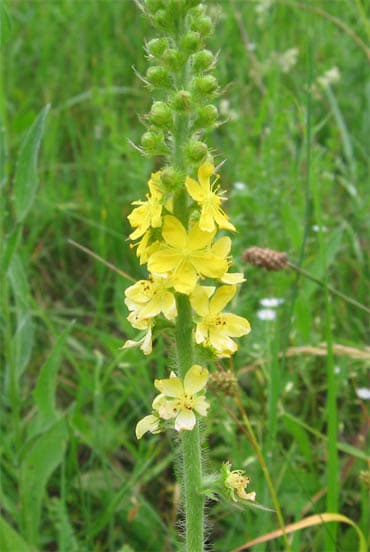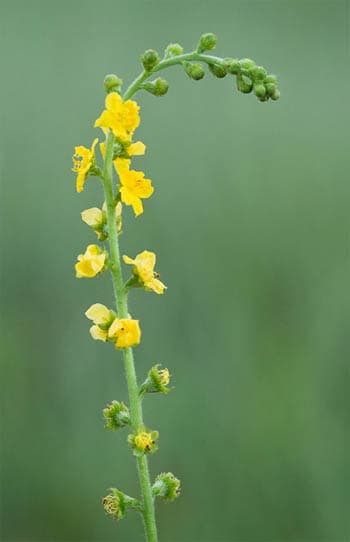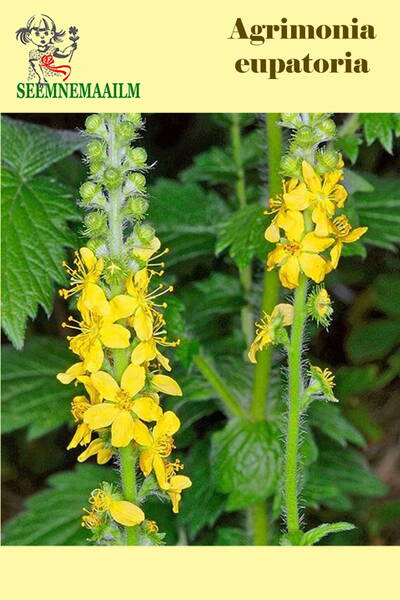Ex Tax: 1.25€
It is a perennial herbaceous aromatic plant of the Rosaceae family, 50-100 cm high. The stem is erect. The leaves are alternate, intermittently pinnate, with stipules.
Blooms in June - July. The flowers are small, golden yellow, collected in spike-shaped inflorescences up to 30 cm long.
The medicinal raw material is grass, sometimes roots. The grass is collected before and during flowering.
Winter hardiness zones: Z3 - Z8.

Growing: in moderately fertile, well-drained soil in sun or partial shade. Propagated by sowing seeds in spring or by division, in spring or autumn.1,0 g = 35 seeds.
When grown in garden plots, the seeds are sown fresh in September-October or in the spring (as soon as the soil thaws) in rows with row spacing of 15 cm to a depth of 2-3 cm. Preferably in places exposed to the sun. For sowing, the largest seeds are selected from the bottom of the ear.
Only a few plants may bloom in the first year. From the second year they all bloom and bear fruit.
Basic care is weeding, loosening and watering during prolonged drought. However, agrimony can grow without care, excluding weeding. Produces abundant self-seeding without becoming a nuisance weed.
Leafy stems are cut at a height of 7-10 cm from the ground. Dry in the shade, under a canopy or in a dryer at a temperature of +40+50 °C. Store in a wooden container for 2 years.
Chemical composition: flowers, leaves and stem are rich in tannin, bitter and mucous substances, contain fragrant essential oil, catechins, steroids, nitrogen-containing compounds, flavonoids, glucose, fructose, sucrose, polysaccharides, traces of vitamin K.


Common agrimony.
* Wonderful agrimony.
For kidney stones and gallstone diseases, one of the best remedies is an infusion of agrimony herb with honey.
The infusion is prepared as follows: take 40 g of raw material per glass of boiling water, leave for 3-4 hours, add honey to taste and take a quarter glass 3-4 times a day. The product has a very pleasant taste and aroma. It not only dissolves stones and sand, but is also able to regulate liver function and also has an anti-inflammatory effect.
In folk medicine in many countries, cocklebur is recommended for the treatment of chronic liver diseases (stones, hepatitis, cirrhosis). In addition, it is used to treat gout, rheumatism, lumbago, hemorrhoids, gastric diseases, intestinal sluggishness, hemoptysis and inflammation of the laryngeal mucosa.
An infusion of the agrimony herb helps well with diseases of the liver and spleen, it eliminates constipation (for liver diseases), and is very useful for diseases of the gallbladder.
Agrimony infusion is effective for benign and malignant tumors, advanced rheumatism.
The healing properties of agrimony are amazing.
Many people are looking, of course, for milk thistle to treat liver diseases (liver cirrhosis and hepatitis). So, agrimony is in no way inferior, and even surpasses its famous girlfriend in this beneficial effect on the liver - it even treats hepatitis C (the most insidious of hepatitis).This herb has been tested over centuries and the experience of generations of herbalists and healers.
But that's not all:
* it crushes stones in the gall bladder, as well as kidney stones (and how it crushes them!): it dissolves small ones and removes them, and crushes large ones and also removes them from the body.
* treats cholecystitis, fatty liver, normalizes its function.
* treats the gastrointestinal tract (diarrhea, flatulence, intestinal polyps, stomach and duodenal ulcers, gastritis, hemorrhoids).
* in combination with St. John's wort, centaury, agrimony in equal parts treats enuresis (both in children and adults). Enuresis recedes even in very advanced cases.
* in combination with coltsfoot, lungwort, St. John's wort, viburnum and chamomile fruits, agrimony treats pulmonary diseases (asthma, bronchitis, tracheitis, pneumonia, acute respiratory infections, influenza).
* treats joint diseases: gout, rheumatism, arthrosis and arthritis.
* gargling with a decoction helps with sore throat and other diseases of the throat and oral cavity. And also for hoarseness and loss of voice (there are cases when agrimony was used to treat cancer of the liver and uterus - since this plant has a pronounced anti-cancer effect).
At home, use an infusion of herbs: 2 tbsp. spoons of dry raw materials are poured into 0.5 liters of water, brought to a boil and left, wrapped, until cooled.
Take a third of a glass three times a day 15 minutes before meals for liver cirrhosis, liver stones, jaundice, rheumatism, and gastrointestinal diseases.
Another infusion recipe: 5 tbsp. spoons of raw materials per half liter of water. Used for rinsing the nasopharynx for a runny nose, inflammation of the mucous membrane of the mouth and throat, for compresses for boils and dermatitis, for baths, washes, lotions for abrasions, ulcers, bruises and rashes.
Decoction of roots: pour 50 g of dry raw materials with half a liter of water, boil for 20 minutes, cool. Use externally for aphthous stomatitis, for washing tumors.
Herbal decoction: 50 g of raw material per half liter of water. Boil until the water is reduced by half. Indicated for uterine bleeding according to Art. spoon every 3 hours.
For sore throat and inflammation of the gallbladder, use powder from finely crushed leaves - 0.5 g per dose three times a day before meals.
A decoction of the lignified (lower) parts of the stem: (50 g of raw material per half liter of water) is used to expel kidney stones - a third of a glass three times a day.
When there is a heavy load on the speech apparatus (teachers, speakers), it is useful to gargle (up to 5 times a day) with a decoction of agrimony leaves mixed with honey: pour 50 g of leaves with half a liter of hot water, bring to a boil, reduce to 2/3 of the original volume, strain and add a teaspoon of honey.
Agrimony is also used in complex collections. Take equal amounts of agrimony grass, Icelandic moss, elderberry bark, coltsfoot flowers and pour 3 tbsp. spoons of the mixture with half a liter of boiling water. Infuse for three hours, boil for another 5 minutes and filter. Take a third of a glass 5 times a day before meals as an expectorant for diseases of the upper respiratory tract.
Mix 2 parts each of agrimony grass, horsetail and centaury and 3 parts each of lingonberry leaves and dill seeds. Pour 3 tbsp. spoons of the collection with a liter of boiling water and leave until cool. Drink 30 g up to 7 times a day (children under 10 years old - a tablespoon three times a day) for bedwetting and bloating.












